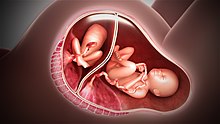Selective reduction
Selective reduction is the practice of reducing the number of
The procedure generally takes two days; the first day for testing to select which fetuses to reduce, and the 2nd day for the procedure itself, in which potassium chloride is injected into the heart of each selected fetus under the guidance of ultrasound imaging.[5] Risks of the procedure include bleeding requiring transfusion, rupture of the uterus, retained placenta, infection, a miscarriage, and prelabor rupture of membranes. Each of these appears to be rare.[4]
Selective reduction was developed in the mid-1980s, as people in the field of assisted reproductive technology became aware of the risks that multiple pregnancies carried for the mother and for the fetuses.[6][7]
Medical use

Selective reduction is used when a mother is carrying an unsafe or undesirable number of fetuses in a
While the data is weak, due to the small sizes of studies and the lack of randomized controlled trials, as of 2017 it appeared that when short term perinatal outcomes in multiple pregnancies reduced to twins are compared to those of non-reduced triplets, there were fewer deaths among the babies born to mothers who underwent reduction, the twins were born later and were less likely to be premature, and had higher birthweight.[8] As of 2017, longterm outcomes were not well understood.[8] A 2015 Cochrane review found no randomized clinical trials to evaluate.[11]
Outcomes
Generally selective reduction reduces the risk of preterm birth, leading to better outcomes for both mothers and the newborns.[12]
It appears that reduction of triplets, where each triplet is in its own placenta, to twins results in a lower risk of preterm birth and does not increase the risk of miscarriage. In triplets where two of the fetuses share a placenta and each has its own amniotic sac, it appears, with less certainty, that there is also a lower risk of preterm birth and no increase in the risk of miscarriage.[2]
Adverse effects
Risks of the procedure include bleeding requiring transfusion, rupture of the uterus, retained placenta, infection, a miscarriage, and prelabor rupture of membranes. Each of these appears to be rare.[4]
Procedure
The reduction procedure is generally carried out during the first trimester of pregnancy. The procedure often takes two days; the first day is for testing, and the procedure happens on the second day. The fetuses are evaluated, first by ultrasound, then often by testing the amniotic fluid and chorionic villus sampling; these tests help determine which fetuses are accessible for the procedure, and whether any fetuses are unhealthy. Once the specific fetuses to be reduced are identified, potassium chloride is injected into the heart of each selected fetus under the guidance of ultrasound imaging; the heart stops and the fetus dies as a result. Generally, the fetal material is reabsorbed into the woman's body.[5]
History
Selective reduction was developed in the mid-1980s, as people in the field of assisted reproductive technology (ART) became aware of the risks that multiple pregnancies carried for the mother and for the fetuses.[6][7] The procedure was somewhat controversial from the beginning and drew some attention from anti-abortion activists.[7]
A set of ethical guidelines was developed in collaboration with a bioethicist from the
Over time, more and more women in the developed world sought to become pregnant when they were older, having the first child when they were over forty years old. At the same time, the number of obstetrician-gynecologists with the required expertise increased and their role in family planning evolved. These trends led to more women asking for reduction to one fetus. These requests increasingly came from women pregnant with twins due to advances in the field of ART which made massively multiple pregnancies rarer. Selective reduction of twins was very controversial at first but has gradually become more accepted. One of the authors of the 1988 guidelines updated his stance and expressed a desire for the procedure to become more available in 2014. Sex-selective reduction is widely considered to be unethical in making decisions about which fetus to keep.[3][5][7]
See also
References
- ^ "UOTW #19 - Ultrasound of the Week". Ultrasound of the Week. 23 September 2014. Archived from the original on 9 May 2017. Retrieved 27 May 2017. Triplets
- ^ S2CID 3778609.
- ^ a b c "Opinion Number 719: Multifetal Pregnancy Reduction". American College of Obstetricians and Gynecologists’ Committee on Ethics. September 2017. Archived from the original on 2019-04-04. Retrieved 2018-10-26.
- ^ PMID 23518032.

- ^ S2CID 5136936.

- ^ a b Mundy, Liza (May 20, 2007). "Too Much to Carry?". Washington Post Magazine. Archived from the original on April 5, 2015.
- ^ a b c d e Padawer, Ruth (August 10, 2011). "The Two-Minus-One Pregnancy". New York Times Magazine.
- ^ PMID 28625760.

- S2CID 40913509.
- ISSN 1467-2561.
- S2CID 38648757.

- S2CID 10307261.
- PMID 3347412.

Further reading
- Gaither, Kecia (January 30, 2018). "Infertility and Reproduction Reference: What Is Multifetal Reduction?". WebMD.
